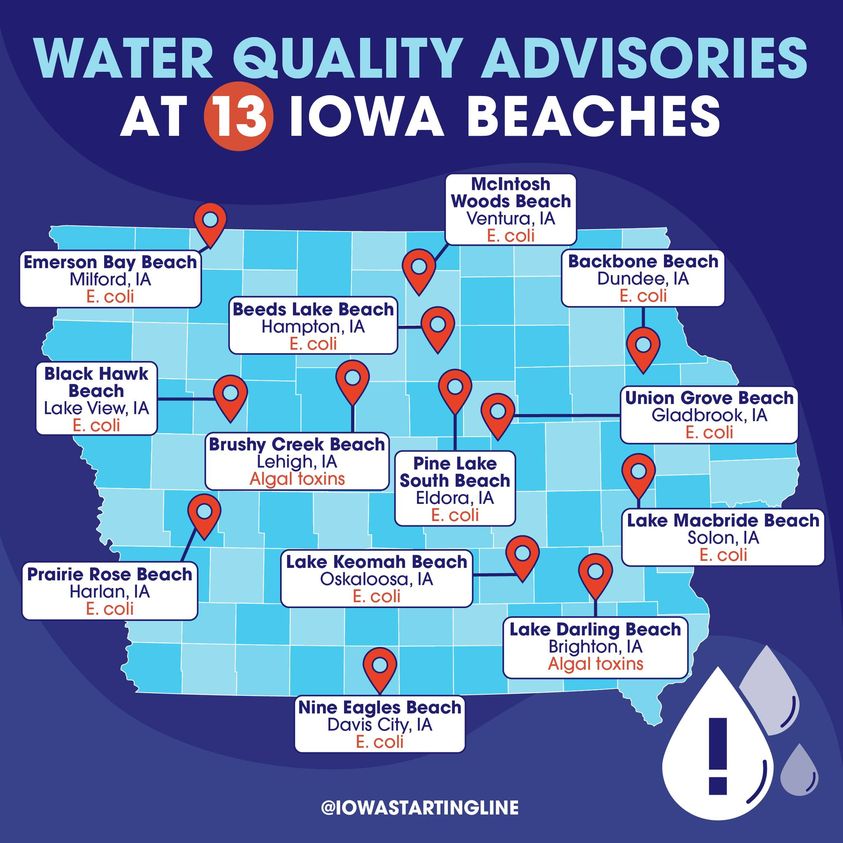
Every year, from Memorial Day to Labor Day, the Iowa Department of Natural Resources (DNR) monitors the water quality at state park beaches and updates it on a weekly basis. When the readings for E. coli and microcystin (algae) toxins reach a certain threshold at those beaches, the DNR issues water quality advisories.
Over the 15 weeks of summer this year, Starting Line and other organizations have monitored those advisories. Now that those advisories have stopped, here’s a summary of how bad it got.
What’s the problem?
Water quality problems are worsened by factors like climate change. When it rains, that rain can be more intense in a shorter amount of time, which worsens runoff.
But climate change is also leading to longer, worsening droughts—Iowa’s drought has now lasted more than 155 weeks—and those can have an effect on water quality, too.
Algae growth and bacteria concentrations, fed by fertilizer, can increase in shallow, warm water. In 2012, another major drought year, a Gazette and Investigate Midwest report shows algal toxins exceeded the state threshold 50 times.
How often were Iowa’s beaches affected?
Over this summer, the DNR issued more than 100 advisories for E. coli and microcystin toxins.
The US Army Corps of Engineers separately issued 19 advisories for E. coli at the six beaches on Iowa reservoirs it monitors and manages. Those don’t appear on the DNR’s reports (Saylorville, Red Rock and Coralville).
By far, the beach with the most advisories this year was Pine Lake South Beach near Eldora. Pine Lake South made the list every week this summer—a first for the water quality list, according to the Iowa Environmental Council, which has tracked these advisories since 2014.
Brushy Creek Beach near LeHigh showed up 10 weeks in a row, always for microcystin algal toxins. Lake Darling, near Brighton, was close behind with nine appearances, eight of which included microcystin advisories.
According to Starting Line’s records, the worst week this summer was July 7, when the DNR marked 13 beaches as not recommended for swimming.

By the end of the summer, plenty of weeks tallied more than 10 advisories.

Though some beaches were tagged multiple weeks, issues weren’t necessarily isolated to specific areas of the state, either.
What are the solutions?
Iowa’s water quality issues have been documented by researchers like Chris Jones, who notes agricultural runoff into Iowa’s waterways is a major contributor to water quality issues.
The Nutrient Reduction Strategy, managed by the DNR, the Iowa Department of Agriculture and Land Stewardship and Iowa State University, is meant to manage those pollution levels. But the biggest problem is that the program is voluntary, and there aren’t explicit goals or deadlines for reaching them.
One solution, advanced by the Iowa Environmental Council, is to strengthen the Nutrient Reduction Strategy by making it mandatory and setting specific goals and a timeline to reach them. Most agree the problem won’t be solved until the agriculture lobby agrees to work with environmentally-minded Iowans.
Nikoel Hytrek
9/20/23
If you enjoy stories like these, make sure to sign up for Iowa Starting Line’s weekly newsletter.
Have a story idea or something I should know? Email me at nikoel@iowastartingline.dream.press. You can also DM me on Twitter at @n_hytrek.
Iowa Starting Line is part of an independent news network and focuses on how state and national decisions impact Iowans’ daily lives. We rely on your financial support to keep our stories free for all to read. You can contribute to us here. Find ISL on TikTok, Instagram, Facebook and Twitter.
1 Comment on "How bad Iowa’s water quality was this summer (and why)"
Good and welcome story, thank you. Three additional points:
1) Fertilizer is definitely a problem, partly because most of Iowa’s topsoil has lost so much carbon structure that it can’t hold nutrients in place. Blame should also go, however, to Iowa’s massive CAFO (factory farm) industry, which contributes enormously to Iowa’s water problems, including beach advisories. Lake Darling is a prime example.
2) The Iowa Nutrient Reduction Strategy is basically a report on where Iowa’s nutrient pollution comes from and suggestions for how to reduce it. It is NOT a strategy. It was never intended to be a strategy. It’s a political shield written to prevent the feds from taking action, and it was created by Big Ag groups in state-held meetings. Conservation groups were not even allowed to attend the meetings.
3) The real Iowa water problem is Iowa voters. In Florida, voters care enough about water quality that even Republicans like DeSantis have to take some kind of action. In Iowa, voters have sent the message “We don’t really care.” And candidates heed that message. The 2022 election showed that clearly. Until that changes, Iowa waters will remain crappy.